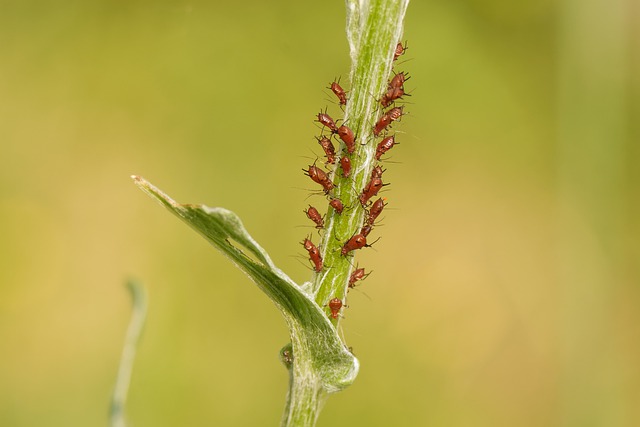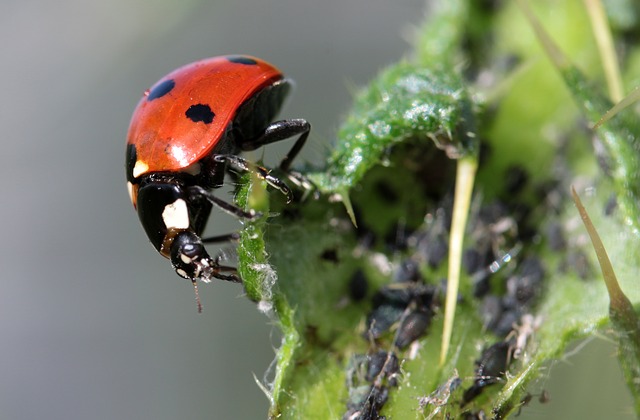Aphids
In our guide you will learn everything about aphids and their control.
- The Aphid – short profile:
- Characteristics, nutrition and reproduction of aphids
- Way of life
- Propagation of aphids
- Occurrence and frequency of aphids
- Types of aphids
- Symptoms of aphid infestation
- Natural enemies
- Aphid YouTube-Video
The Aphid – short profile:
- belong to the plant lice family
- feed on plant juice
- damage plants through their sucking activity
- settle on leaves – mainly on and on the veins of the leaves
- In addition, the aphids particularly affect sensitive parts of plants such as buds and flowers
- Reproduce quickly
- Shoots and whole plants can die after aphid infestation

Characteristics, nutrition and reproduction of aphids
Aphids are also called Aphidoidea and belong to the genus of plant lice. Around 3000 species are known worldwide, of which around 850 are common in Central Europe. All of them have one thing in common – they feed on plant sap. Many species are considered pests of useful or ornamental plants in private gardens or in agriculture.
The traces of them go back to 280 million years.
They are small insects a few millimeters in size. The largest species grow to be around seven millimeters long. The aphids are equipped with proboscis for sucking plant sap. Winged aphids can also develop in the change of generations, but most species of lice do not have wings. The winged generations only serve to spread and change hosts.
The small one use their proboscis to deliberately prick the leaves and veins of the plant to suck from them. They absorb the amino acids contained in the plant sap. The juice contains a lot of carbohydrates and is excreted by the aphids as a sugar-like solution (honeydew). This attracts further insects or serves as a breeding ground for fungi.
Most species alternate between the generations. Once only males emerge once only females, but it can happen that up to forty generations of females hatch. In many species, reproduction has been lost, so that females can lay eggs without male interaction.
Economic damage
In addition to economic damage, aphids also cause agricultural and horticultural damage. The lice pose a significant problem for professional gardeners, landscape gardeners and hobby gardeners. A heavy infestation can lead to crop failures. Aphids transmit diseases from plants by being able to transmit the viruses.
Virus and disease infestation is usually greater than the damage caused by aphids.
Many animals such as wasps, ants, bees and even some vertebrates use the honeydew excreted by the lice as a source of food.
Virtually all types of plants can be infected. The lice are usually found on the undersides of the leaves on buds or on flowers.
Depending on the weather, aphids can multiply epidemically and live with thousands on one plant.
Some species of aphids even form a symbiosis with ants that like to feed on carbohydrate-containing or, better, sugar water – including honeydew. The ants take care of the aphids and protect them to support their spread.

| Tribe | Arthropod |
| Class | Insects |
| Subclass | Flying insects |
| Order | Beak insects |
| Suborder | Plant lice |
| Superfamily | Aphids |
| Scientific name | Aphidoid |
Way of life
Besides snails, aphids are the most common plant pests and, together with scale insects, mealybugs and whiteflies, belong to the group of plant lice. The term tube aphids would be scientifically correct.
Almost all aphid species hibernate in an egg on the host plants. They reproduce asexually after the first hatching. This means that asexual offspring can create simple clones that are exactly like yourself. In this way, the aphid is able to create numerous offspring. As a rule, it takes a week for the formation of a sexually mature generation to be fully completed.
After several generations, offspring with wings usually emerge, which should then colonize new plants and secure their existence.
The rule is that winged aphids can only reproduce sexually. Males and female also appear in later generations towards summer.
Most of them live in dense colonies and groups on their host plants. They prick the plant shoots, leaves, buds and flowers with their proboscis and suck out the plant sap. The lice excrete most of the sugar juice. This is called honeydew. Honeydew is a reliable symptom of louse infestation.
Ants find this juice very attractive and feed on it – yes they literally milk the aphids. The ants also defend the lice against ladybugs and other predators.
Propagation of aphids
They can lay eggs or even give birth alive. Most of the time they multiply by laying eggs. A female can lay forty to a hundred eggs. Aphids can reproduce sexually as well as sexually. At the beginning of the populations mostly asexual animals grow up. These can build up a population quickly as they can create up to 5 living clones per day. These clones are genetically identical to their mother.
Warm and dry climates favor the multiplication. Aphid females are very fertile at warm temperatures of around 25 degrees Celsius.

The development time is usually between one and two weeks. The life expectancy of an aphid is only a few weeks.
Depending on the climatic zone or generation, sex animals emerge at the end of a summer and at the beginning of autumn, the females of which can lay eggs. These eggs can hibernate in Central Europe and secure the population of the next year.
They can be selfless. Like many other pests, cause galls to form and pathological they grow on plants. The aphids live in these holes. Now try to get moths into the hole, pump the aphids up to a third of their body fluid to wear out the hole again and protect the remaining lice. It serves as protection for the aphids and is placed over the wound of the hole like a plaster. Some lice stick to the plaster, sacrificing their lives for survival.
Occurrence and frequency of aphids
Aphids are one of the most common insects on plants in the garden and in nature. There are around 800 species only in Central Europe and over 300 around the world. A single aphid cannot do much harm, but the aphids usually occur with hundreds to thousands of plants and can also multiply quickly. Therefore, amounts of aphids can cause great damage to plants, gardens and also in agriculture. Aphids occur on almost all types of plants and annoy hobby gardeners and professionals.
They feed on the sap of their host plants. With their tools, they penetrate deep into the tissue of the plant and then suck the juice out of its veins. They suck the juice from the trunk, bark, leaves, shoots, buds and prefer to stay at so-called nodes, because this is where the most plant juice flows. The honeydew which is excreted in large quantities also damages the plants in that fungi maintain a nutrient medium and the plant is prevented from photosynthesis or is inhibited. In addition, honeydew attracts other insects that can also harm the plant.
Different seasons
Aphids reproduce with the rising temperatures in spring. Their propagation works best at temperatures around 25 degrees Celsius and in a shady environment. When they reproduce, the aphids can adapt to nature and the season. The females lay their eggs in autumn. These eggs can hibernate and new aphid larvae hatch from them in spring. These larvae become sexually mature only a few weeks after hatching and in turn give birth to new generations.
The problem is that the aphid population can also increase if they encounter natural enemies. If aphids are attacked by a ladybug, for example, they can increase larval production and thus give birth to around 5 larvae per day. As a result of the attack, other aphids emit a kind of fragrance or pheromone, which increases the activity of the other lice and leads to the immediate increased generation of offspring. The aphid population can quickly become overpopulated because it produces produce regardless of whether it feels comfortable or feels threatened.
Because of this and the enormous distribution, the aphids are among the most dangerous pests on all plants. They can destroy entire crops and this can mean crop failures.
They are also transmit viruses, which can also harm the plant.
Types of aphids
- Real aphids
- Aphids (green peach aphid, black bean aphid, pea aphid, rose aphid, black currant aphid, Sitkalaus)
- Tree lice (beech crab louse, oak bark louse, pine bark louse)
- Aphids (spiral gall louse, lettuce root lice)
- Mindaridae
- Mask lice
- Anoecildae
- Bristle lice
- Ornamental lice (beech aphid)
- Adelgoidea
- Adelgidae (fir lice, pine lice, spruce gall louse, Douglas fir
- Phylloxeroidea (dwarf lice, vine lice)
Symptoms of aphid infestation
The leaves are covered with a sticky coating. The shoots, leaves, buds and flowers are littered with the small pests. It is usually green, black or red. The leaves, flowers and other parts of the plant can curl, dry up or cripple after aphids have said on their shoots. The aphid secretes a solution containing sugar. This is called honeydew. Soot fungi can accumulate on this solution. There are lice with wings that can spread very quickly in your garden. They hibernate in an egg on the plants, shoots and shrubs, so that the following year there is a rapid infestation.
Natural enemies
- Ladybug
- Hoverfly
- Gall mosquito
- Lacewing
- be crazy
- Birds
- Many other insects
Aphid YouTube-Video
Black, green, white, they are in almost all colors and shapes – some even with wings, shells and shields.
- Large rose aphids usually settle on roses. These are green or pink and suck not only from roses but also from apple and pear trees. They have also been spotted on strawberries several times.
- Black bean aphids infest beans, potatoes, carrots, viburnums and cones.
- Apple aphids are mostly found on fruit trees. They mainly drink the sap from apples, pears and quince trees.
- Green peach aphids are mostly found on fruit trees. But they don’t stop at vegetables or weeds either.
- Yellow aphids mostly attack oleanders.
- White aphids, mealybugs and spider mites are at home on many plants.